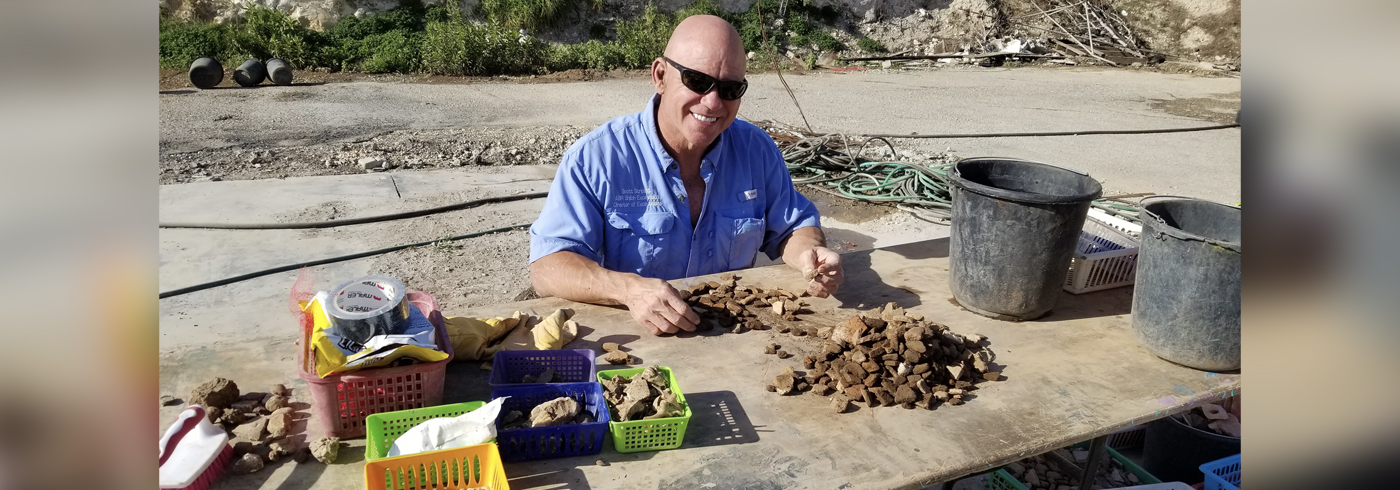Miniature Tablet Confirms Biblical History
 Writing on an ancient lead tablet — also known as an amulet — confirms Scripture passages in the Old Testament in a very precise manner.
Writing on an ancient lead tablet — also known as an amulet — confirms Scripture passages in the Old Testament in a very precise manner.
Archaeologists have announced that the discovery of a lead tablet from the Late Bronze Age in Israel has proven to be one of the most significant historical and biblical discoveries in the past 50 years. The tablet not only debunks theorists who claimed the early Israelites were illiterate and therefore could not have written the Pentateuch, but also confirms texts in Scripture.
Scott Stripling, an AG Theological Seminary graduate and tour teacher for the Center for Holy Lands Studies (CHLS), is the provost and director of the Archeology Institute at The Bible Seminary in Katy, Texas. He is also the director of excavations for the Associates for Biblical Research, the researchers responsible for the discovery of the “oldest known Proto-Hebrew inscription ever found.” Stripling is currently excavating Shiloh.
A recently completed scanning and translation of the miniature (2 centimeters x 4 centimeters/roughly .8 inches x 1.6 inches) tablet revealed an ancient written curse and the covenant name of God (YWH) — the significance of the location of the find, the curse, and the covenant name of God has biblical archeologists excited for good reason.
HOW IT BEGAN
Stripling says that the tablet was discovered in a debris pile from Adam Zertal’s excavation (1982–1989) on Mt. Ebal of what was believed (and confirmed) to be the site of an altar built by Joshua when the early Israelites crossed into the Promised Land.
“Through previous experience, I learned that dry sifting with a wire sieve is not nearly as effective as wet sifting,” Stripling says. “We discovered that with wet sifting (using water) we can see much more than before — we’ve been throwing away 75 to 80% of the small finds from the past. For each glyphic artifact found (with dry sifting), I found four in their dump pile.”
Armed with that knowledge, Stripling decided going through Zertal’s dump pile, which was only dry sifted, was well worth the effort. So, he raised the funds, gathered a team, received the proper permissions, and in 2019 began work on the first 30% of the pile.
In December 2019, the tablet was discovered. However, shortly after that time COVID-19 began sweeping the world, and the sifting project was ended and the ability to have the fragile tablet scanned (using high-tech scanners capable of scanning through lead in the Czech Republic) was put on hold until this year, with the discovery being officially announced on March 24.
A TABLET, AN AMULET
Referred to as a tablet because it was folded in half, Stripling says that through the exhaustive scanning process, it became evident that the tablet was an amulet — an amulet that contained 40 proto-Hebrew letters on the inside that when translated into English, revealed a written curse.
The ancient Hebrew inscription reads:
“Cursed, cursed, cursed — cursed by the God YWH.
You will die cursed.
Cursed you will surely die.
Cursed by YWH — cursed, cursed, cursed.”
Amulets are typically seen as good luck charms or used to ward off evil spirits, but in this case, it contained a self-imprecatory curse upon the people of Israel. To the layman, this might seem like something an evil person might do to an enemy. To the archeological biblical scholar, this is a treasure trove of incredible confirmations of biblical accuracy.
SIGNIFICANCE OF THE AMULET
There are several revelations that the amulet (tablet) provides.
First, Stripling explains that the amulet’s lead has been chemically tested and confirmed to have come from a mine in Greece, as it has the same composition as other items found throughout the ancient world known to have come from that mine, which is dated to the Late Bronze Age II (ca. 1400 to 1200 BC) — the time of Moses and Joshua.
The amulet also proves that during this time, the Hebrews were literate — at least Moses, Joshua, and the Levites could read and write as they made use of a proto-alphabetic writing. Again, supporting what Scripture says in such verses as Exodus 34:27 (God telling Moses to write), Exodus 38:21 (Moses telling the Levites to write), and Joshua 1:8 (God telling Joshua to read). Significant because some scholars believe the former Hebrew slaves were incapable of writing as they were thought to have no alphabet, thereby questioning the authorship of the early parts of the Old Testament.
The translation of the writing also proves hugely impactful. At first, one might question that the amulet may not have been dropped there by the early Israelites, for why would any early Israelites place curses on themselves? But that’s exactly where the Bible and the writing on the amulet undeniably intertwine.
Referencing Scripture once again, Stripling points to Moses’ directions to the people in Deuteronomy 27:12,13: “When you have crossed the Jordan, these tribes shall stand on Mount Gerizim to bless the people: Simeon, Levi, Judah, Issachar, Joseph and Benjamin. And these tribes shall stand on Mount Ebal to pronounce curses (emphasis added): Reuben, Gad, Asher, Zebulun, Dan and Naphtali.”
Mount Ebal was to be the place where Moses directed six of the tribes to go to express curses on Israel if the people failed to follow God’s commands — the finding of an amulet expressing curses in that location is no coincidence. Also, there was only one people group in the world at that time who worshipped God YWH (as written in the amulet) — the Israelites.”
“The Covenant name of God, YWH, confirmed in Israel in the earliest possible period!” Stripling exclaims. “It has been found in Egypt, the Sinai, and now Israel itself — that’s enormous. It’s the oldest Hebrew text found by several hundred years . . . and the characters date to the Late Bronze Age IB/IIA horizon (ca. 1400 BC).”
Jeremy Stein, educational content development and teaching strategist for CHLS, states: “To find such an artifact with potentially huge impact on our biblical understanding serves to show the importance not just of biblical archaeology as a whole, but also a renewed need possibly to revisit sites that have been excavated in the past as was Mt. Ebal.”
OTHER DISCOVERIES
Stripling says that in addition to the discovery of the amulet, several other items of significance have been found.
“We also recovered a bronze pen, a stylus used for writing,” Stripling says. “This supports Job’s request (Job 19:23,24) to have his words inscribed on lead with an iron pen. And we found a bronze blade, rounded on the end, that was possibly used to sacrifice animals, which falls in line with the construction of (Joshua 8:30,31) and later Zertal’s finding of the altar on Mt. Ebal.”
Stripling then brings the altar, the amulet, and the directions of Moses together: “As the tablet (amulet) was found in the altar on Mt. Ebal, the place of curses, it demonstrates that even if people are guilty of violating the Covenant, if they come to the altar, forgiveness, through the shedding of blood, is given; if you don’t repent, those curses come upon you.”
With this discovery, one can only wonder what other evidence of ancient biblical significance could still be hidden in the remaining 70% of Zertal’s debris pile? Stripling says he’s working to find out.
“I’m in the process of raising funds to return to wet sift through the remaining debris,” Stripling says. “The recovery of the amulet lends credibility to the accuracy and authenticity of the Bible — and I believe there’s much more still to be found.”
Stein readily agrees.
“The new methodology and newly advanced technologies, such as fully functioning wet sifts and computer imaging, allow us to see exactly what we may have missed when our methods and manners in which we carried out excavations were less evolved,” Stein says. “It leaves us ever-so-curious of what more is still to come and be found in the future!”
Photo provided by Michael C. Luddeni.


